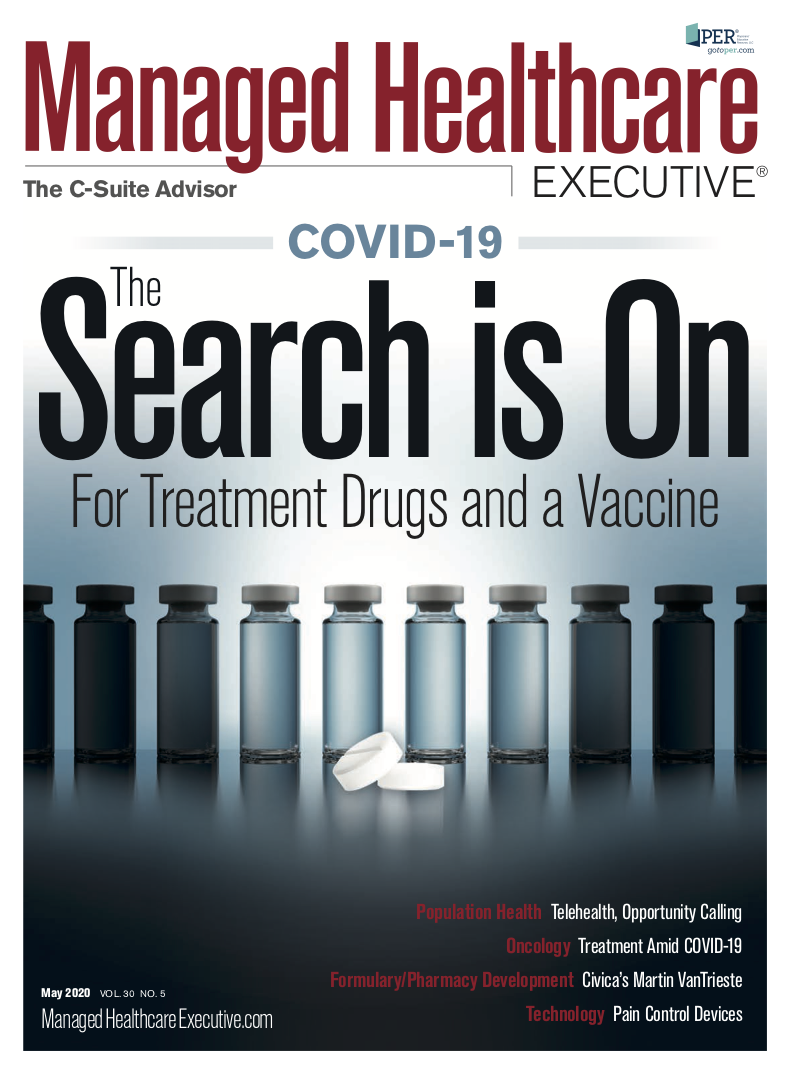Cancer Care in the Time of COVID-19 and After
Patients and their oncologists are weighing the pros and cons of delaying treatment. Once the outbreak subsides, how might the practice of oncology change?

COVID-19 is not an equal-opportunity illness. Older people and patients with chronic conditions are, on average, far more vulnerable to suffering serious illness and death from the disease than younger people without ongoing health problems. Although the data are not as clear, cancer patients are also among those vulnerable to the SARS-CoV-2 virus that causes COVID-19 and more likely to suffer its serious consequences.
Oncologists around the country, supported and informed by guidance from healthcare leaders and professional associations, are reviewing the available research and carefully weighing treatment decisions. Many patients, with their physicians, are wrestling with question of whether the risks associated with putting off their cancer treatment are greater than the risk of COVID-19.
Randall Oyer, M.D., a medical oncologist at Lancaster General Health, a health system in Lancaster, Pennsylvania, says that in addition to understanding that cancer patients are a vulnerable group, healthcare leaders need to recognize that cancer patients are at heightened risk of contracting COVID-19 in the hospital.
Oyer says research from early COVID-19 hot spots such as China, Italy and the Seattle area suggests that patients with lung, liver and some types of gastrointestinal tumors, as well as hematologic malignancies, are at greater risk of suffering COVID-19 than patients with other kinds of cancer. Sparse as these data may be, they should still guide decision-making by oncologists and healthcare leaders, Oyer says. Many professional associations are providing guidance to oncologists during the outbreak, including the Association of Community Cancer Centers (Oyer is the president), the American Society of Clinical Oncology, the American Society of Hematology, the American Society for Radiation Oncology and the American College of Surgeons.
‘Agility and collaboration’
Patients with cancers of the lung, the liver and possibly the gastrointestinal system are at increased risk of COVID-19 because the SARS-CoV-2 virus attaches to the angiotensin-converting enzyme 2 (ACE2) that is highly expressed in these organs and system, explains Oyer. ACE2 “paves the way” to cancer cells in these areas and acts as a “welcome mat” for SARS-CoV-2, he says.
It’s a different story with hematologic cancers, which include the leukemias, the lymphomas and multiple myeloma. The cancers themselves reduce immunity and make people vulnerable to infection because they interfere with the production of healthy levels of lymphocytes. In addition, the treatment of hematologic cancers targets the immune system and the bone marrow to get rid of the malignant cells, but it also affects noncancerous cells, further suppressing the patient’s immunologic defenses. Oyer describes the process as one in which “the bouncer’s (been) removed from the door” and can’t defend against the virus.
Masumi Ueda, M.D., M.A., assistant medical director for inpatient blood and bone marrow transplant at the Seattle Cancer Care Alliance, a hospital in its namesake city, says patients with compromised immune systems should adhere to the core recommendations for preventing COVID-19: Wash your hands, and maintain social distancing. “Aside from that, there’s not much more than we can do in the absence of a vaccine,” she says.
Ueda was the lead author of an article in the April 2020 issue of the Journal of the National Comprehensive Cancer Network describing the changes that the Seattle cancer hospital made in response to the COVID-19 outbreak. The title is telling: “Managing Cancer Care During the COVID-19 Pandemic: Agility and Collaboration Toward a Common Goal.” Ueda and her colleagues mingled advice with brief accounts of the steps they took to respond to COVID-19:
- The first step is robust infection and environmental control. Patients with respiratory symptoms need to be triaged. In Seattle, wrote Ueda and her colleagues, they had early access to testing and could perform nasopharyngeal swabs on symptomatic patients that met COVID-19 testing criteria.
- Healthcare leaders need to strictly reinforce “stay at home when ill” policies and establish other policies for testing staff, tracking exposures and defining when people can return to work.
- Forming an “incident command” structure is necessary to centralize information. Leaders need to hold virtual town halls.
- Outpatient well visits were rescheduled or handled through telemedicine visits, and telemedicine capabilities and training were ramped up. Hours of operation were added to make sure that emergency departments and hospital resources were used only by those needing high-level care.
- Adjuvant therapy with curative intent for patients with solid tumors should likely proceed.
- Decisions about delaying treatment should factor in whether delays may lead to inpatient admissions for symptom palliation that would burden hospitals.
- Stem cell transplants and cellular immunotherapies provide curative treatment and can’t be delayed in many cases.
- By speaking to patients on the phone, surgeons optimized decision-making about delays in surgery.
- Oncology disease groups were given the job of determining which treatments might reduce the risks of immunosuppression. They also weighed whether treatments might be moved from an inpatient to outpatient setting or delayed.
Ueda’s area of expertise is in stem cell transplant. She says not much data exist about whether patients undergoing the procedure, which involves a period of severe immunosuppression, do in fact have a higher risk of experiencing serious COVID-19-related illness. But as a rule, she notes, patients undergoing immunosuppressive cancer treatments such as stem cell transplants are more vulnerable to infection and serious illness from viral diseases like COVID-19.
The number of patients with cancer and COVID-19 has been relatively low at Seattle Cancer Care Alliance. “I think we were lucky as an institution,” says Ueda, noting the center’s relatively early access to testing. Still, she’s cautious about what the future holds. Her hospital is preparing to revamp its cancer care operations once the worst of the pandemic has subsided. Among the changes in the offing might be greater use of telehealth.
To delay or not to delay
The COVID-19 outbreak has put nearly every medical service on hold and forced patients and physicians to do some cost-benefit thinking about diagnosis and treatment, now and later. But the decision to delay cancer treatment is especially fraught, and the seesaw of cost-benefit, huge. Delay could give an aggressive cancer an opportunity to progress, but treatment may lower immunity. J. Leonard Lichtenfeld, M.D., MACP, deputy chief medical officer at the American Cancer Society in its Atlanta headquarters, says the society’s around-the-clock call center has received questions from many patients whose cancer treatments have been stopped or put on hold. “Every cancer center is struggling with this,” he says.
Richard Van Etten, M.D., Ph.D., a stem cell transplant specialist at the University of California, Irvine, and director of its Chao Family Comprehensive Cancer Center, says the decision to delay care depends on the type of treatment. For autologous stem cell transplants, which involve using the patient’s stem cells, continuing treatment is plausible if the patient doesn’t have COVID-19. Maintenance therapy is also an option for these patients and would allow them to undergo the procedure later.
Allogeneic stem cell treatment, which involves using stem cells from a donor, presents a greater challenge, says Van Etten, because these patients can be profoundly immunosuppressed for up to a year after treatment. Many of these patients can’t wait long for a transplant, so moving forward with the procedure, and ensuring the patient is isolated afterward, may make sense, provided they don’t have COVID-19.
Post-COVID-19 oncology
Oyer, a practicing oncologist for 40 years, describes himself as an optimist. He is challenging healthcare leaders and oncologists to use this experience with COVID-19 to transform cancer care. For example, patients undergoing treatment might be given the option of checkups using telehealth, which will increase convenience, he says. Oyer also notes how quickly medical journals have published articles about COVID-19. The evidence they have presented has helped professional organizations keep their guidelines timely and relevant.
Healthcare organizations should start planning now for when the worst of the outbreak is over, says Lichtenfeld. “There’s going to be an incredible rush to the door of patients seeking treatment,” he notes, and careful triage of patients is going to be important. He also recommends proactive communication with patients about when they will resume treatment. In addition, healthcare leaders must support staff members with employee assistance programs, he says.
“Everyone has a story,” Lichtenfeld says. “Everyone wants to be comforted, and staff will have emotional and community-based issues they have to deal with.”
Aine Cryts is a healthcare writer based in Boston.

Analysis Finds Brukinsa May Provide Costs Savings Over Imbruvica in CLL
April 14th 2025In a statistical analysis, Brukinsa resulted in fewer cases of disease progression or death and resulted in lower overall healthcare costs than Imbruvica in patients with chronic lymphocytic leukemia.
Read More
Rutgers Cancer Institute Reviews Guidelines for Managing Blood Cancers During Pregnancy
April 8th 2025About 6% of pregnancy-related cancers are Hodgkin lymphoma, and 5% are non-Hodgkin lymphoma. Leukemias in pregnancy are rarer, accounting for 1 in 10,000 pregnancies. The most common pregnancy-related leukemias are acute myeloid leukemia (AML), acute lymphoblastic leukemia (ALL), and chronic myeloid leukemia (CML).
Read More
Using the 'Pathway' Approach to Shorten the Time Between Cancer Diagnosis and Treatment
November 16th 2022In this episode of Tuning In to the C-Suite, Briana Contreras, editor with Managed Healthcare Executive spoke with Dr. Yuri Fesko, oncologist and vice president of Medical Affairs at Quest Diagnostics. In the conversation, Dr. Fesko addressed the ongoing issue of long gaps of times between receiving a diagnosis for a type of cancer and finally getting the treatment for it. Dr. Fesko shared the benefits a number of sectors receive when treating patients sooner and the steps to get there.
Listen
CAR T-Cell Therapy Cuts Costs, Reduces Treatment in Mantle Cell Lymphoma
March 13th 2025In a real-world study, researchers found this data by comparing treatment patterns, healthcare resource utilization, and costs between patients receiving CAR T-cell therapy and those treated with the non-CAR T standard of care.
Read More